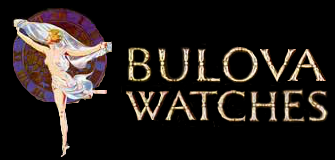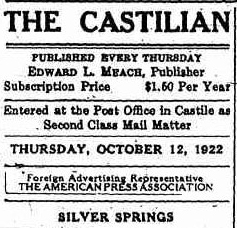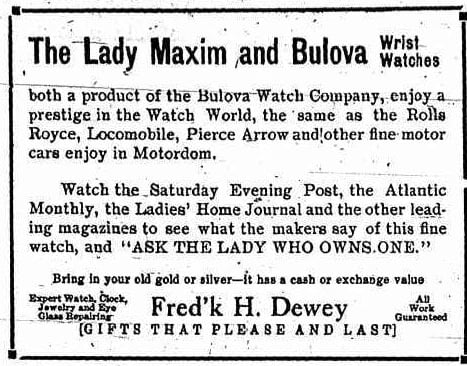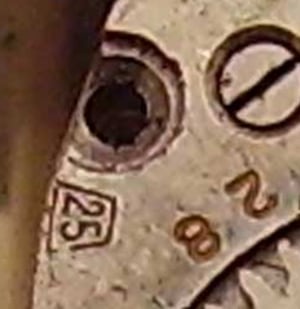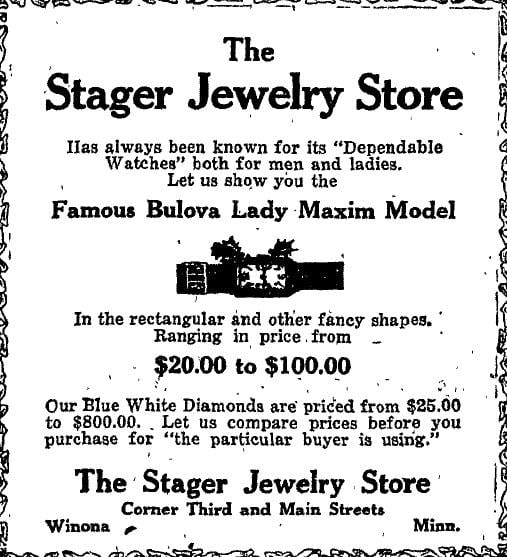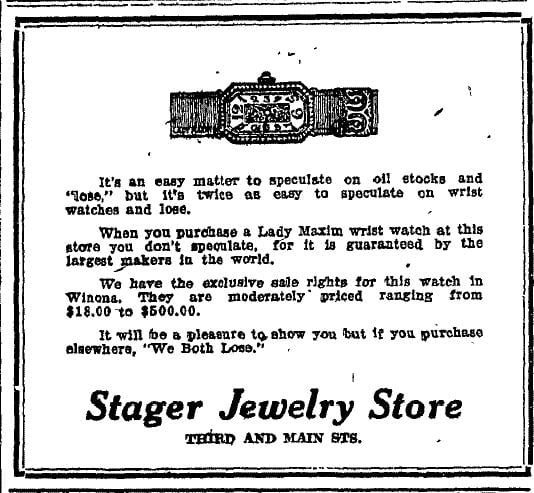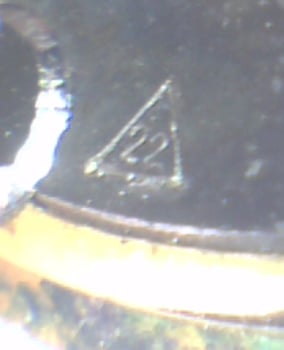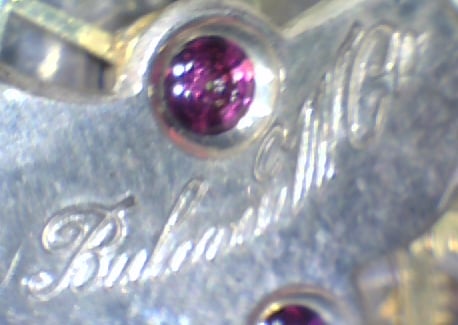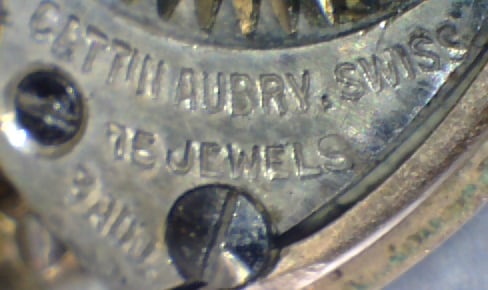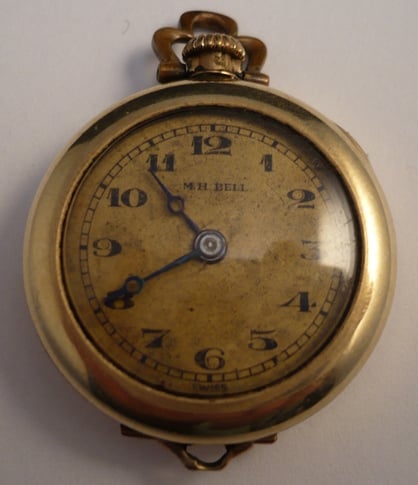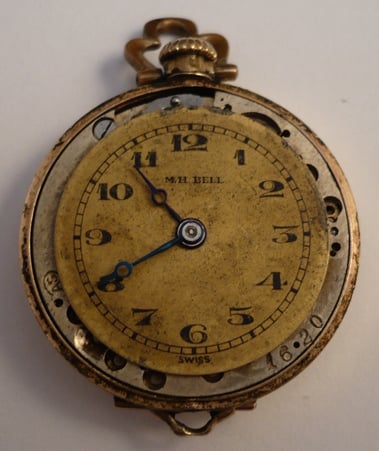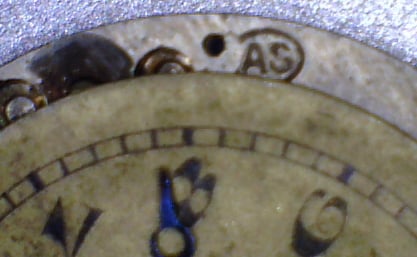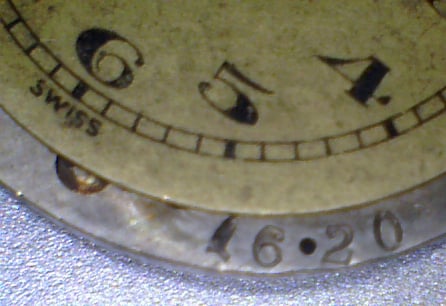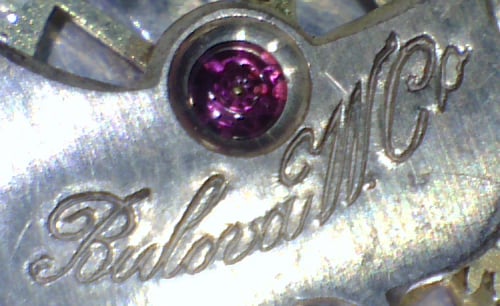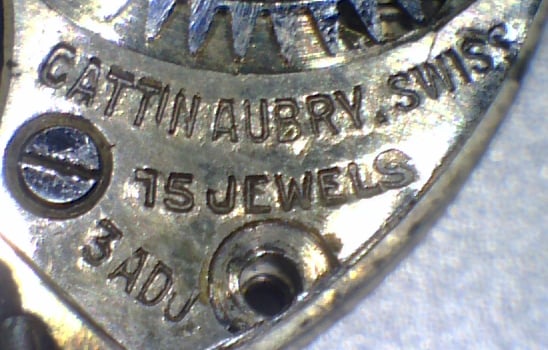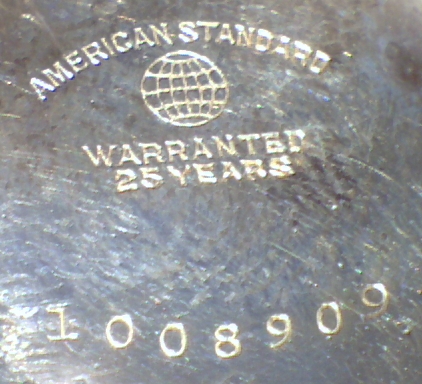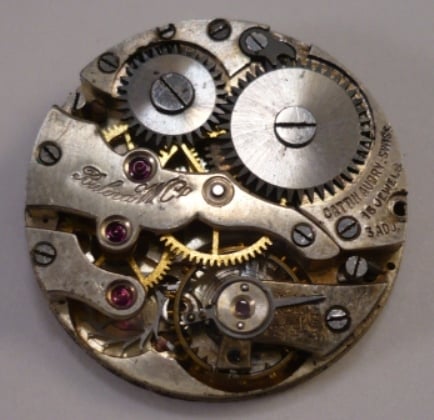Retracing Bulova History.
The Bulova Corporation was founded in 1875 by Czech immigrant Joseph Bulova in a small premises on Maiden Lane, New York City.
By 1911, Joseph Bulova had set up manufacturing to build high quality boudoir clocks, table clocks and pocket watches and by the following year (1912) Joseph Bulova was able to establish his first dedicated Watch manufacturing and assembly plant in Bienne, Switzerland, building only quality fully jeweled movements.
'At about the time of the First World War, there were many European watch manufacturers that said that the wearing of a watch on the wrist would never be a popular alternative to the pocket watch. Joseph Bulova, creating a pioneering spirit that was to become the 'culture' of Bulova, started to experiment with compact spring and balance wheel timepieces that could withstand the impacts and shocks of being worn on the wrist. Out of only a handful of manufacturers of the day, Bulova introduced its first line of fully jeweled men's wristwatches in 1919'
So, where are these 'Bulova Watches' Dating from 1911 to 1921 You may ask?
The clues are right before Us.
The first clue was recently discoverd in an ad which appeared in a 1922 Cosmopolitan Magazine.
* Note: the ad reads:
J. Bulova Co. Fifth Avenue at 36th Street. New York
Makers of the famous HUDSON MAXIM and RUBAIYAT Watches.
The image appears to be Copyrighted 1920 or 1921 and there is no mention of Bulova Watch Co in fact to the contary, the ad reads J. Bulova Co.
Clue 2.
In 1917 a Patent was issued to the J. Bulova Co.
*Note: there is no notation of when this Patent was applied for or when the Name 'Rubaiyat' was first used by the J. Bulova Co
Clue 3.
Enter into the picture this piece:
The Watch shown above is a First World War era (WWI 1914 - 1918) Gent's wrist Watch, correctly Jeweled (7) for Military issue at the time, manufactured in Switzerland, signed on both Case and Movement Rubaiyat W. Co. in the very same fashion, identically even, to early movements signed Bulova W. Co., which appear around 1921. Also please note the Rubaiyat signature on the Movement rolls the same way depicted in the Patent issued to J. Bulova Co.
What does this mean?
It is My contention that this Rubaiyat W Co. signed piece is the early work of Joseph Bulova manufactured while operating as the J. Bulova Co. pre Bulova Watch Company and the reason We do not see any 'Bulova Watches' pre Dating the early 1920's is that they do not exist. They do, only during the Decade of 1911-1921 Mr Joseph Bulova of the J. Bulova Co was manufacturing His famous Watches from the facility in Bienne, Switzerland under the Names of 'Rubaiyat' and 'Maxim' as indicated by the early 1920's ad.
This contention would also help explain early 1920's Watches which are American Standard Cased Bulova signed Movements with Maxim, Rubaiyat or nothing at all printed on their Dials, as J. Bulova Co grew and morphed into Bulova Watch Company, casing and timing Watches downstairs from the newly constructed Bulova observatory on Fifth Avenue, New York.
Many thanks to Mr Stephen Oilman, owner/admin of MyBulova.com for allowing the presentation of this information on site and to fellow MyBulova members who take time to read, evaluate, enjoy or critique.
Mark.
Fifth Avenue Restorations.
In reply to J. Bulova Co. moves from 2 by mybulova_admin
Fifth Ave at 36th St mentioned in the snippet above is the location of the 1905 Gorham building (392 Fifth Ave?).
The address I have for the Bulova Observatory is 580 Fifth Ave on what's known today as the World Diamond Tower http://www.580worlddiamondtower.com/history.htm formerly known as the Empire Trust Company Building, which was the former Ampico Towers.
lol
The building at 580 Fifh Ave is showing as competed in 1927. http://www.skyscrapercenter.com/new-york-city/empire-trust-company-buil…
and 1929 http://www.emporis.com/building/empiretrustcompanybuilding-newyorkcity-…
The World Diamond Tower link gives a building permit issuance Date of 1927.
If this information is correct the Bulova Observatory could not have been in operation until 1929 at the earliest, which the database ads reflect. http://www.mybulova.com/sites/default/files/vintage_ads/bulova%20ad%201…
One to watch for:

Everett Watch Co
No indication of a Date but typically when J. Bulova & Cie. is mentioned it's an older record.

image above is of an 'Everett Watch Co. New York' Swiss Pocket Watch - 7 Jewels.
http://www.propertyroom.com/l/l/7997312
I cannot get the image of the movement to load
* this description from an Everett Watch Co pocket Watch recently auctioned:
"Having a circular dial, with Roman numeral chapters, subsidiary seconds dial, 7 jewel stem wind manual movement, having 2 adjustments, concealed within a yellow gold-filled hunting case #2138690. Signed on movement Factory S, Switzerland and on dial Everett Watch Co., New York. Movement size approximately 0".
http://www.worthpoint.com/worthopedia/everett-watch-co-yellow-gold-fill…
No images - interestingly the Movement was signed 'Factory S.'
I hadn't noticed this before, but there are a few Bulova model names that exist that are both Bulova AND Westfield. ie: Air King, Air Queen, American Boy, American Girl, Sky King, Trojan, Miss Liberty, etc. I'm wondering if the cases are identical, and swapping has occurred.
There is a lot of info at Mikrolisk, including what appears to be all of the Bulova Model name patents.
It looks like Bulova patented/trademarked many model names and lots of stuff under different company names too. Many are non-USA registered. Many don't have dates associated w/ the info for each entry. I think they just registered things to secure the names/trademarks, and didn't necessarily "do anything" with some of them short of this.
I don't think cases btwn Bulova and Westfield were identical or even "close", but Bulova wanted some options, and to keep others from marketing a competing product?
In reply to Dial signed 'HUDSON MAXIM' by FifthAvenueRes…
Will,
Considering the published information that 'Bulova introduced its first line of fully Jeweled Gent's wristwatches in 1919' and the "Makers of the famous Hudson Maxim Watches" statement in the fine print of the J. Bulova Co ad Dated 1922.
Manufactured between 1919-1922.
preliminary indications are the font used on the Hudson Maxim Dial signature is the same as found on an early Maxim brand pocket Watch (signed Case, Movement and Dial) shown below on the left.

This font also matches the font used on Dials signed Rubaiyat and those later signed Bulova.
Here is a Rubaiyat the went through the bay a couple weeks ago, Rubaiyat on the dial, American Standard case, Bulova BII 15J movement just like one that I have in the movement database...
http://www.mybulova.com/node/1029
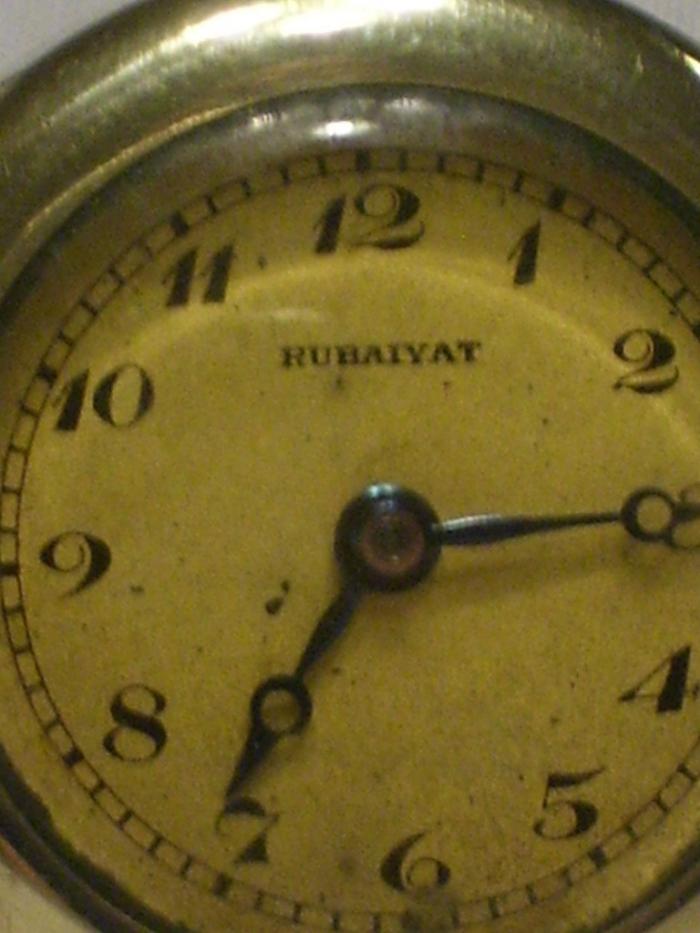
rSg~~60_57.jpg)
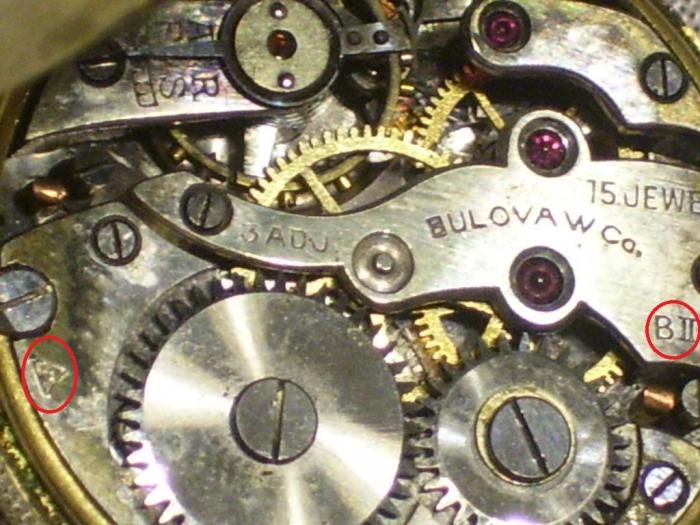
Note the triangle on the left side of the movement...just like the one that I have in the movement database.
Watches I have seen branded Maxim are very different than the Bulova examples. I recently saw one that was a Roskopf. There were several companies that used the Maxim name as a brand, but they are easily distinguishable from the Bulova made Maxim models, at least in the ones I have seen so far.
In reply to Watches I have seen branded by Reverend Rob
2 new images of the Hudson Maxim


* a point of interest on this example is the Porcelain Dial.
Stem is at the 3 O'Clock position.
Noting 'MAXIM' is the prominant Name on the Dial Will, I'd have to say MAXIM is a brand, the 'Lady' MAXIM and 'Hudson' MAXIM are models associated with the brand.

This reasoning would also suggest the early pieces signed 'RUBAIYAT' on the Dial as Greg shows were also a brand and not a Bulova model at this period in time.

What We are seeing are 2 companies - 'MAXIM' and 'RUBAIYAT' morphing, merging and forming Bulova Watch Company Inc.
I'm leaning towards the model "Maxim", Lady and Hudson, without there being a Maxim brand per se, owned by Bulova. There were already several Maxim brands in Europe, which Joseph would have been well aware of. He may not have been convinced, at this point in his life, that putting his own name on the watch was a good move, recognition wise. However, we clearly see he came quickly to this idea, and Bulova was born as a brand. I tend to view both the Rubaiyats and the Maxim models as Bulovas, kind of like viewing a Wilsdorf and Davis pocket watch as a Rolex, despite predating the name.
In reply to Five Hundred Bucks for a Lady by Reverend Rob
It IS a lot of money! But also, you have to remember that the wristwatch was a brand-new item, a mechanical marvel in miniaturisation. If you compare the pocket calculator when it came out (I remember when it came out, our senior science and maths buffs at school had just finished building a computer from scratch, it only did what a pocket calculator did, but it fit in a double wardrobe!) in 1972, they cost about a couple of weeks wages.
We have an ad for the solid Platinum Phantom pocket model, at $1,000 too!
In reply to Hey Mark, here is a shot of by DarHin
So during this brief time period, did the J Bulova Co make a series of Models named Lady Maxim under the J Bulova name, or was J Bulova Co the parent company of "Maxim Watch Co" ? How were the movements stamped? It appears from the ads directly above, the Model series was "Lady Maxim" made by J Bulova Co. I'm not seeing the little "whited out" area with BULOVA on the actual watch graphics, as is seen in other watch graphics of this period which we "know" were marketed as Bulova (whether the name was on the dial or not).
In reply to Here's another movement found by DarHin
In reply to Darren, Is the a shot of the by FifthAvenueRes…
Will, the watch is advertised as the famous "Bulova Lady Maxim" wrist watch, so I would think it is a Bulova brand.
None of the early ads in the DB have the little "Bulova" sign in them, yet we do not question their validity.
What about this then? Early Bulova watches had numbers instead of names, right? So what if all these numbered watches, mens and womens, came under the Lady Maxim or Hudson Maxim model name? We do see some watches with the names on the dial, but not many, and only the Lady and Hudson Maxim and the Rubaiyat name.
We know there was a "Maxim Watch Co., a Hudson Watch Co. and they are probably, if not definitely subs of Bulova, but when the wristwatch market blossomed, what is easier than using established and well known and easily recognisable names on/for their new product?
The obvious next step is when the market expands so much, and the wristwatch is in big demand and new models are needed to cater for the customer, numbers were dropped and names used instead, much easier to remember and not so impersonal as a number. In the early days of wrist watches people could say, "I have a Bulova Lady Maxim or Hudson Maxim", but as more models were made, who wants to say, " I have a 2266 or 3579"? Let's not forget it was all about marketing, and Joseph certainly knew his market!
Worth thinking about hmm?
Stephen, I am sorry if I seem a little ignorant but I have come in at a late stage and have not seen much of your theories apart from the LE parts, and if it seems like I am re-hashing old threads, I apologise, but I have come to the above theory on my own and have not read about it anywhere here or elsewhere. I am really happy to have been of some help (if I indeed have), and look forward to helping more in the future.
In reply to Stephen, I am sorry if I seem by bobbee
Nothing to be sorry about Bob, I was just making an observation that it is good to see other member making their own theories and comments that resemble those of my own and now that we have more and more evidence to give weight to our theories we are seeing a general exceptance where as before they may have been put down as daft ideas. The work everyone here is doing, both little and large is helping to put many of the vintage Bulova pieces finally together. It's far from complete but that's part of the fun knowing that there is still more of the puzzle to be solved. Our theories and thoughts no matter how daft they may sound at the time may very well help us all solve the next piece of the puzzle. All I can say is a big thank you to everyone for all the hard work!
I've said it before, and I'll say it again:
There were distinct, separate companies called "Hudson Watch Co.", (ca 1884) and they have absolutely nothing to do with Bulova. The model name "Maxim" was used by a variety of companies in Europe, not the least of which was Droz & Cie and Junghans, and WestClox and Waltham this side of the ocean.
Hudson Maxim, and Lady Maxim were registered and used by Bulova as model names. I do not believe Bulova was the parent company of any such other watch co as named above.
The Maxims I have seen that are non-Bulova in Origin are easily discernible from Bulova products. Bulova also used the shortened name, "Maxim".
Rubaiyat was also used as a model name by Bulova, and I do not beolieve this represents a separate company, either. Obviously we are seeing Bulova movts and watch dials without the Bulova name, and I believe Joseph did not always mark his products this way early on. Perhaps he was unsure of how far he would eventually go.
Rob, I came across a very interesting bit of information recently whilst searching for info on Maiden Lane, and it makes very interesting reading. I have here a link to the document in question and if you read from the last paragraph on page three on to the first paragraph on page four, it concerns the Jewelry and Watch businesses of the 19th-20th C.
Bob.
Here's some previously posted trademark info below - the "Everett Watch Company"
If we could find something like info above, linking J Bulova to " Rubaiyat W. Co, Swiss"
Perhpas before incorporation- before "Bulova Watch Company, INC" there was simply "J. Bulova & Cie". A date for inception of Bulova Watch Company, INC. would be great. And perhpas, like Everette Watch Co, the pre-incorprated Bulova had a subsidary named "Rubaiyat W Co".
Or am I just repeating things we already suspect....
EDIT: The full watch from which I got the Rubaiytat graphic above is in the root record, along with its particulars.
The inception of 'Bulova Watch Company Inc.' ( abbrevition for Incorporated)' occurred in 1924.
Websters defines Incorporate this way:
b : to blend or combine thoroughly.
In 1924 Joseph Bulova, then doing buisness as J. Bulova Co. united, blended or combined thoroughly several aspects of buisness to form Bulova Watch Company Incorporated.
I was thinking it could have been late 1923 and it just took a while (1924) for them to get various "changes" put in place. The date of the Everett Watch Co trademark/pattent info from is inferred by the Bulova Watch Co INC being included in the middle field. I betcha this date could have been 1923..... The reason's I'm wondering....possibel pre incorporation use of Rubaiyat as a Bulova subsidary could have been rolled into the incorporated company and we just don't have that info...yet....
Joseph Bulova was incorporated at the start, in 1875. That is the registration of the corporation. The Company itself may have changed names slightly, from J. Bulova Co., to Bulova Watch Company (1923), but at all times these are corporations. It is not a requirement by law to include 'Inc" in the advertised name, which is the same today. Despite the Rubaiyat Watch Co, and other markings on casebacks, I am unconvinced that these are full fledged companies in their own right, and merely an experiment on the part of Bulova at the time.
Is it possible that Bulova took over a little known watch brand that had failed or was faltering? Yes. This is a fuzzy area in Bulova history.
Watchco states that Bulova began branding pocket watches in 1911, but I can't say I've ever seen such a one.
In reply to Joseph Bulova was by Reverend Rob
